On Sunday I finally got to see the Great Tapestry of Scotland. I was completely blown away by the vision of Alistair Moffat (who produced the tapestry’s historical content and context), Andrew Crummy (the superb artist who designed these 160 panels) and perhaps especially by the skill and beauty of the work of the thousand Scottish women and men who stitched it. It was displayed in the singularly fitting surroundings of the Anchor Mill in Paisley. The atmosphere in this wonderful space was electric. There were people of all ages there, and everyone was completely transfixed by the tapestry, and were clearly enjoying it tremendously. I heard several exclamations of delight at particular details, as well as folk sharing personal recollections in front of individual panels. Some of the panels moved me to tears, others made me laugh out loud and viewing this terrific work was a truly incredible experience.
The Great Tapestry of Scotland has a monunmental name, and it is certainly a monumental thing – but importantly, it is not in the least pompous or in any way up itself. Rather than telling the story of a nation through a top-down celebratory narrative of kings and queens and battles, it tells that story from the bottom up, in pleasingly piecemeal fashion, allowing many different identities, and many regional and linguistic differences to be included and represented. Scotland here is the sum of many different parts, and historical change is an uneven, and often deeply conflicted process. And this is a history where the folk who worked to build a bridge might be celebrated in the same terms as the engineer who designed it; where a can of Irn Bru and the King James bible might both share status as national icons. The tapestry’s 160 panels are alive with the colours of the landscape, with cultural invention, with the power of the imagination, with the emotive movement of time, with joy, wit, terror and sadness. That the panels sing so is testament both to Andrew Crummy’s wonderful designs as well as the skill and creativity of the stitchers, and I was deeply moved by the beauty and energy of the embroidery. The story of the people who stitched it is stitched up in this incredible thing, and that is certainly part of what makes it so terrific. So I think it was the tapestry’s sheer sense of shared endeavour that killed me most: that this was the best kind of collective history, created collectively. Craft and design have, I think, a unique power to bring people together in the expression and sharing of their creativity and cultural identity. In all honesty, this tapestry is the best example I’ve ever seen of how this might be so.
This blog serves several functions, one of which is as my own diary. I have thought quite hard about how to represent the tapestry to you, and to myself as well, so that, in the future, I can remember what I felt when I first saw it. I decided that the best way was, over several posts, to show you some of the details that really struck me. If you are interested in finding out more about the Great Tapestry of Scotland, two super books have been published about it. The first, a paperback by Susan Mansfield and Alistair Moffat, tells the story of the tapestry’s creation, together with the stories of the thousand Scottish women and men who were involved in its creation. The second book is a handsome (yet very reasonably priced volume) which carefully illustrates each of the tapestry’s individual panels, alongside more detailed and thorough historical information. I heartily recommend both books. And if you’d just like to look at each of the tapestry’s panels, you’ll find a wee slideshow here.
So here are some of the details I enjoyed from panels 1 through 23
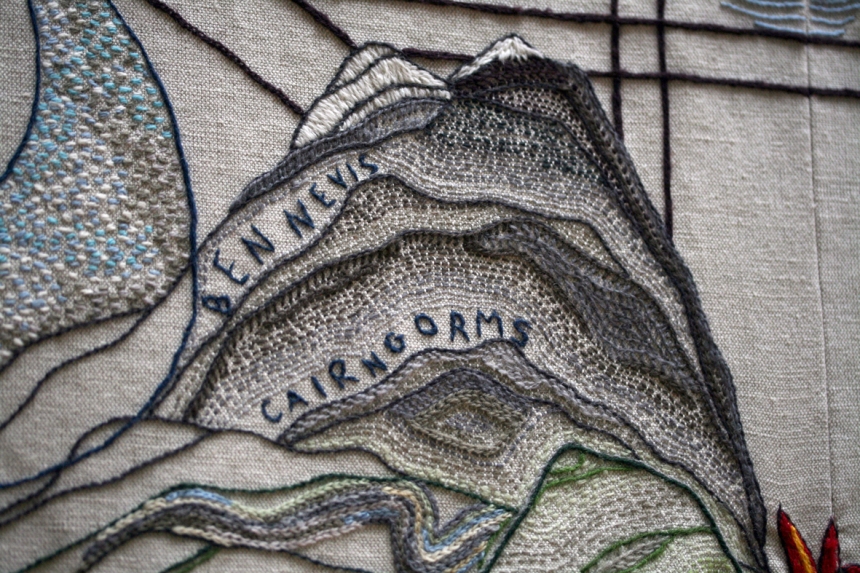
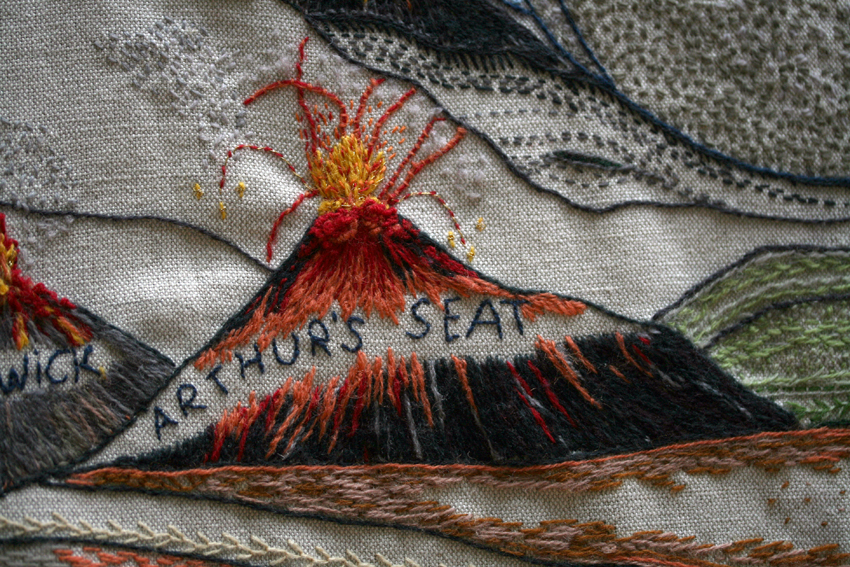
Panels 3a and 3b The formation of Scotland / The collision. “Geology formed Scotland and the land and the sea formed the character of the people”

Panel 4 Scotland emerges from the ice. Love the figures of the fisherfolk, the detail of the currach, the graded colours of the stitching.


Panel 5: The wildwood Hare and Red Squirrel.
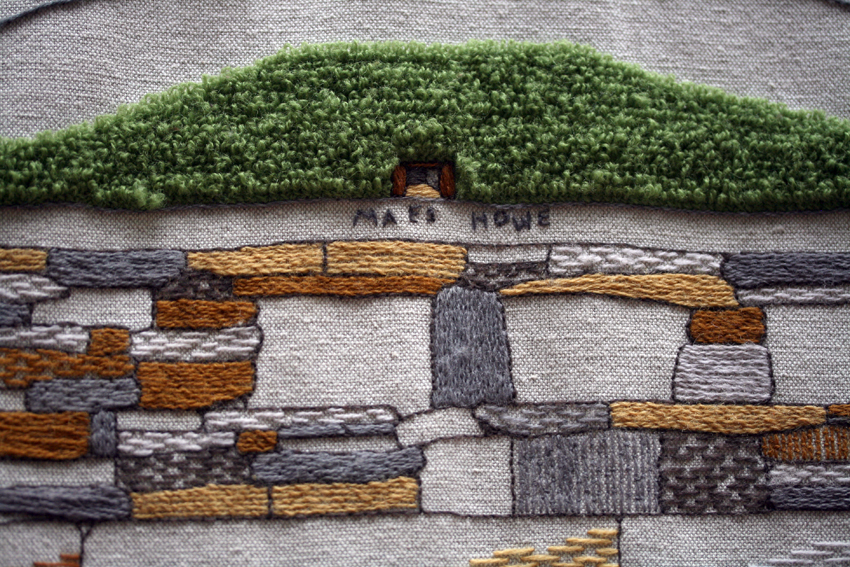
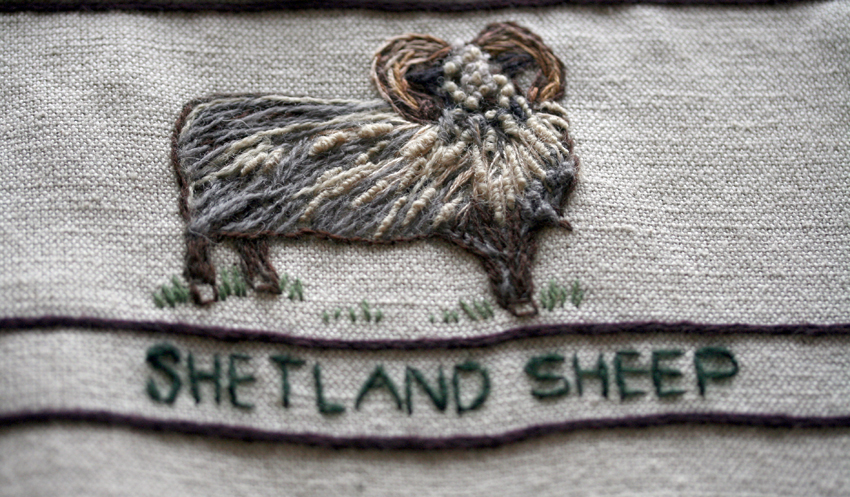
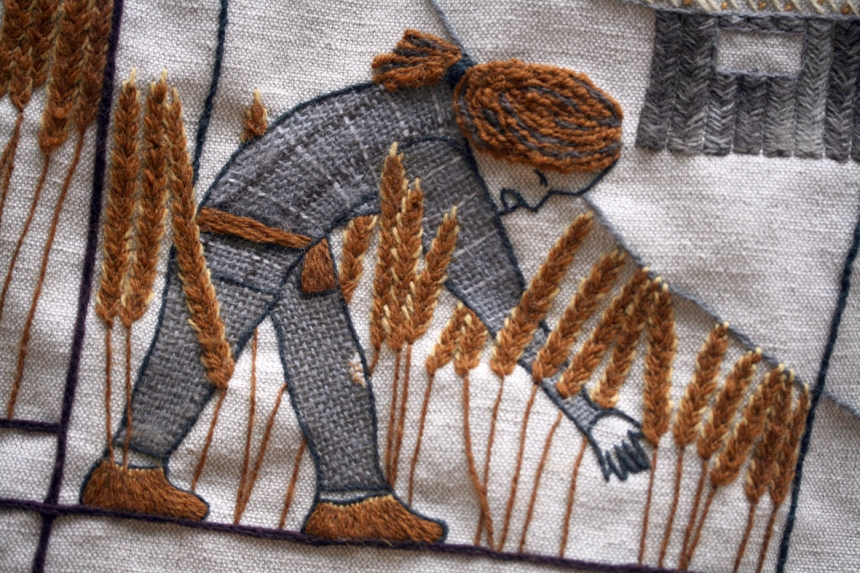
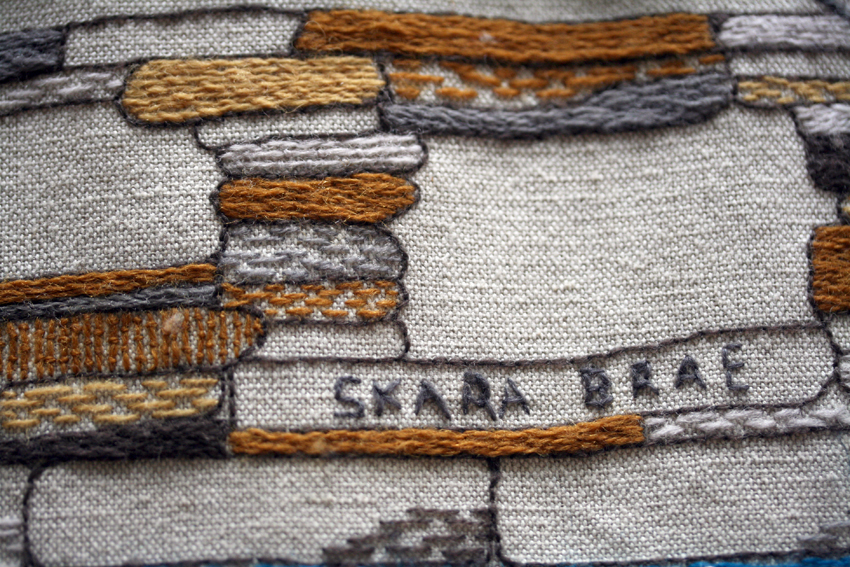
Panel 7: The First Farmers Wonderful textures on this panel.
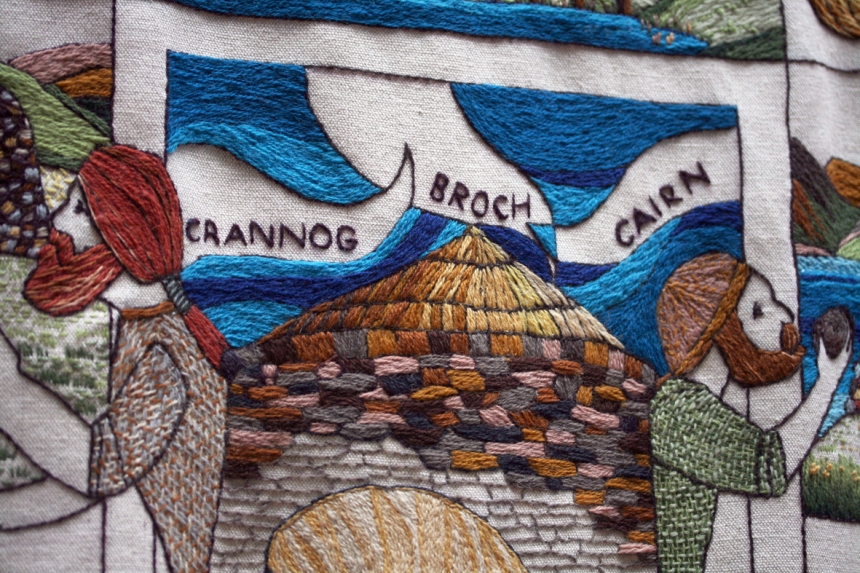
Panel 8: Brochs, Crannogs and Cairns. Scotland’s early vernacular architecture.
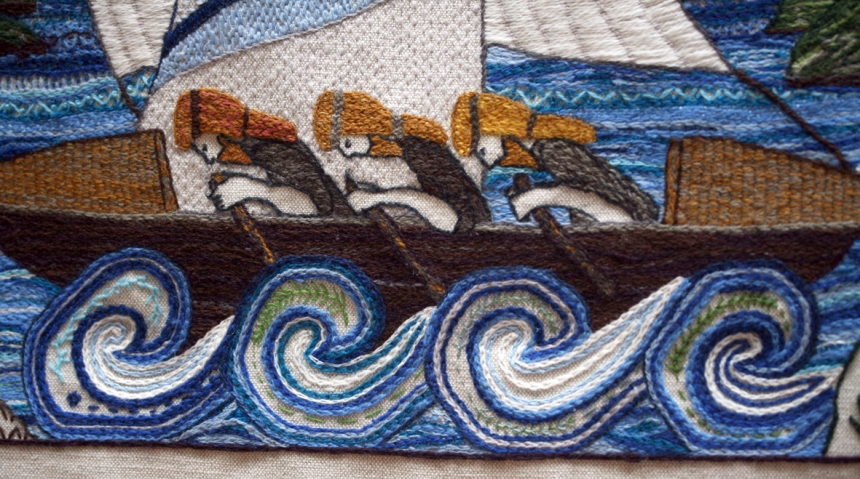
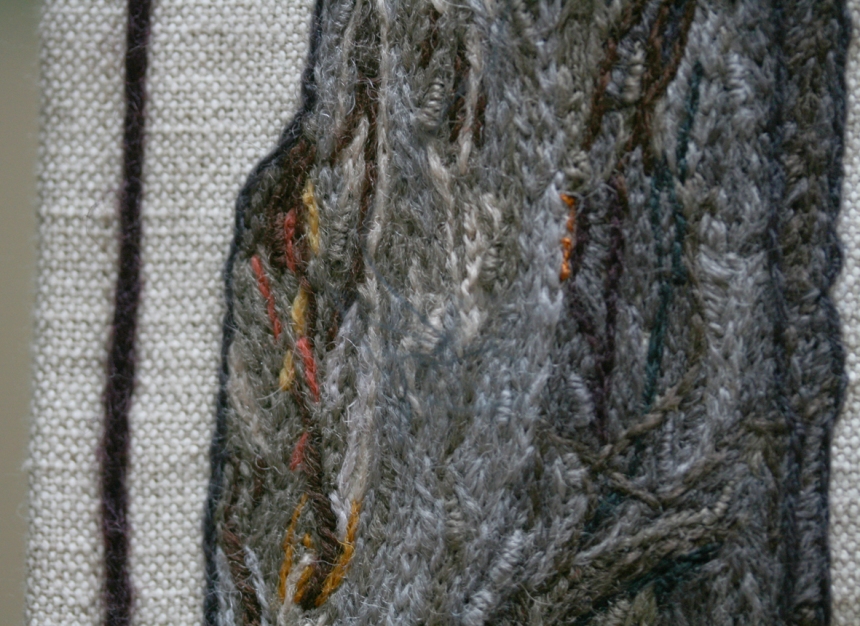
Panel 9: Pytheas the Greek visits Calanais. I was particularly struck by the way the Isle of Lewis stitchers had carefully rendered the colours and textures of the banded gneiss and lichen of the Calanais stones.

Panel 10: The coming of the legions. I love how the curls of Julius Agricola tell the story.
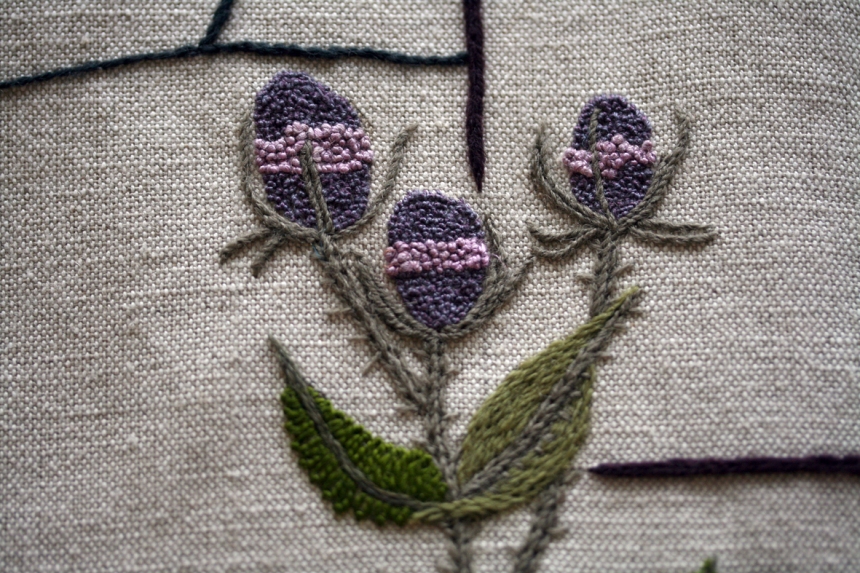
Panel 11: Ninian at Whithorn. Beautiful stitching, the work of a single Dumfries needlewoman, Shirley McKeand.
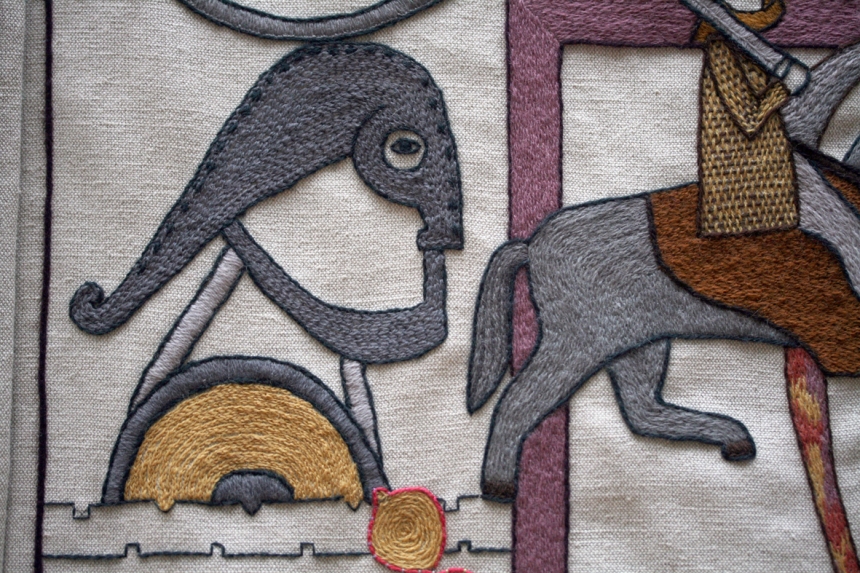
Panel 15: Dunnichen. Love the bold way that Andrew Crummy and the stitchers have here rendered the details of the famous Pictish stone.
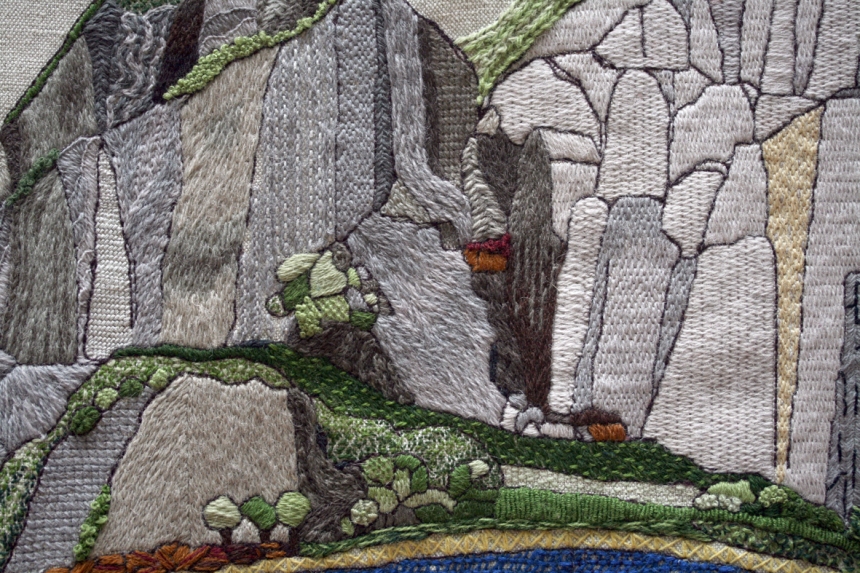
Panel 17: Dumbarton Rock One of many examples of how the geology represented in the tapestry afforded the stitchers an opportunity to really show off their skills. Astounding.
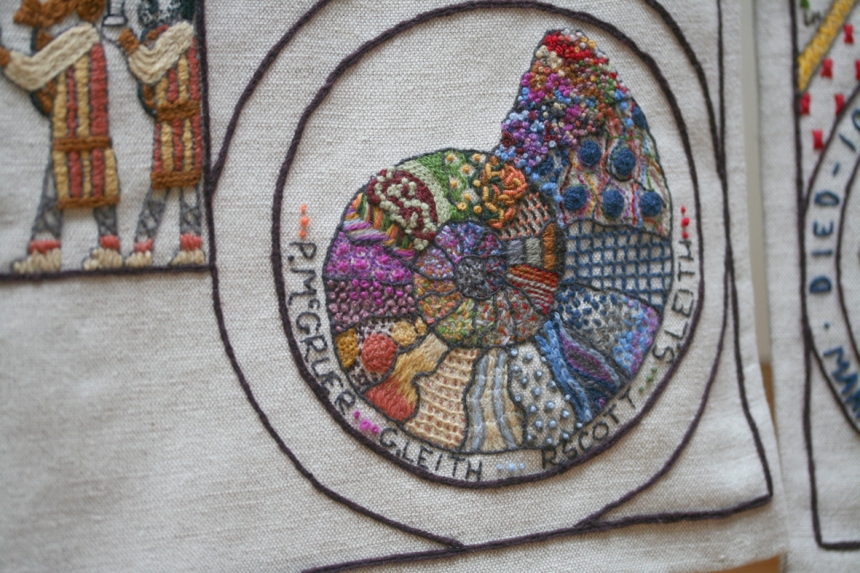
Panel 20: Macbeth. Each of the tapestry’s panels includes the ‘signature’ of the stitchers who created it at the bottom right. This one, a small sampler of every stitch and every colour used in the panel was particularly striking. The panel was stitched by Sandra and Glennie Leith, Ingrid McGown, Paddy McGruer and Rhea Scott.

Panel 22: The Flowers of the Borders. Anyone familiar with the architecture of the great Border abbeys will find the subtle pinks and greys of these stitched columns immediately evocative.

Panel 23: the medieval wool trade. One of many panels illustrating the importance of textiles and their production to Scotland’s culture and economy.
More to come . . .

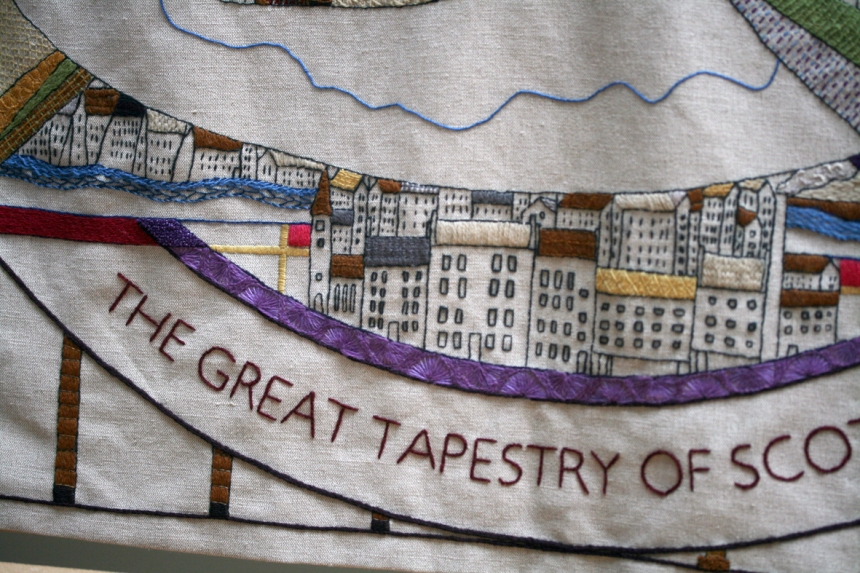

Fascinating! Wish I could see it in person….
LikeLike
Thank you for your retelling of the tapestry – you have added to my original pleasure. The photos are wonderful – I took only one photo for teaching purposes (the establishment of the NHS) and it is a very poor image in comparison.
LikeLike
Reblogged this on One small stitch and commented:
magnificent! thank you for the beautiful, detailed photos. I am putting a link on my blog so others can enjoy.
LikeLike
Thank you so much for this rich, rich post, Kate!
LikeLike
What a treat to see this. Fabulous.
LikeLike
Beautiful pictures Kate. I knew that you would go to see it – I saw it last week and found it very emotional. The venue was perfect and I was especially interested because my gran worked in this mill.
LikeLike
What an interesting and wonderful collaboration of work. I agree with the previous comments about the balance of colours and space allowing the viewer to enjoy all the detail, depth and space. Thank you for sharing and giving such inspiration….
LikeLike
As a textile artist who enjoys spinning, dyeing, knitting and weaving, I wonder why this beautiful work of art is referred to as a tapestry when it clearly is not? Don’t we, the fiber arts community owe it to the generall public to use correct terminology? Am honestly curious about this.
LikeLike
See also ‘The Battle of Prestonpans Tapestry’ and ‘The Scottish Diaspora Tapestry’.
LikeLike
Fabulous Tapestry, a credit to everyone who worked on it. Exquisite work
LikeLike
These are so lovely thank you so much for sharing with all of us! I’m trying to complete my masters in Knitting to the knitting Guild of America and I have to write a paper on the history and this will help you so much. Again thank you for sharing!!
LikeLike
Kate, thank you so much for doing all of this. I was stunned to see your first post, and now even more to see. What a treat! I tried to post a response, but it didn’t work yesterday.
I wanted to say how stunning, and what a fine example of balance and colours. For me, ‘more is less’ here, the spaces giving breathe, and consequently life, to the piece. Ironically, it’s breath-taking…!
LikeLike
Such beautiful work I am not surprised you loved it so much! Everything seems instilled with such vibrancy. I have only ever seen something similar when I viewed The Quaker Tapestry in Kendal. Lots of panels too depicting Quaker history and sewn by a worldwide community. Looking through your photos and remember The Quaker Tapestry too I just want to rush and pick up needle and thread and sew something, anything….
LikeLike
wow wow wow wow!! stunning!
LikeLike
Oh, oh, oh – I am so envious you have actually seen it! From the photographs I have seen (and yours are marvellous) it looks absolutely extraordinary.Absolutely worth every second spent on it!
LikeLike
what an absolute treasure. it must have felt incredibly powerful standing near it, the collective energy of the many many stitchers who created it surrounding you. i can’t imagine. i really want to embroider now!
LikeLike
Stunning!
LikeLike
Awesome!
LikeLike
Something else I will miss because we are not going home this year. Thank you for bringing it to us.
LikeLike
This brings to mind the beautiful tapestry of Queen Mathilde,at Bayeux, relating the Battle of Hastings, that has endured and is still visible a thousand years later (or close). This beautiful work will no doubt remain for generations to see. What an oustanding work of art: thanks for sharing this story and so many beautiful pictures with us.
LikeLike
WOW
LikeLike
Leaves me speechless… I do crewel work and REALLY appreciate what they have done. Rivals the Bayeux tapestry in many respects. Thank you so much for the slide show.
LikeLike
PS Does it have a permanent home?
LikeLike
Wow – absolutely breathtaking. Thanks for sharing – it must be so amazing to see it in person.
LikeLike
How lovely to see that. I wouldnt have known about it at all apart from seeing it here.
Thank you
LikeLike
I saw it twice when it came to Aberdeen Art Gallery. It was heaving on my first visit so I went back for one of the late evening openings and it was much better. Reasonably quiet and peaceful and you had space to really look at each panel. It did make me cry. I loved the representation of the history and evolution of Scotland. Beautiful work and I only wish my skills were such that I could have contributed too.
LikeLike
Oh! This is just so stunning! Thank you so much for sharing your photos here. I don’t know when I’ll go to Scotland again but I am so grateful for the armchair travels. I’m just blown away by the size and the scope. How did they do it so wonderfully?!
LikeLike
this is amazing – truly!
LikeLike
Wow.. ! Seeing those details… the Great Tapestry must be overwhelming as well as breathtaking.. Beautiful pictures !
LikeLike
Absolutely AMAZING, thank you or sharing this wonderful piece of work.
LikeLike
Stunning.
LikeLike
It’s fabulous isn’t it! I actually saw you there on Sun but I wasn’t bold enough to say hello. It was when you were just passing the Macbeth panel, possible my favourite one, but so hard to choose. I have to say I disagree with you about the books. I would have loved a memento of this wonderful work and a record of the history associated with each panel. I thought the photos in the books were very poor though, just the single one of each panel and no close-ups of the lovely little motifs incorporated in the panels nor any showing the gorgeous colours, textures and details of the stitching.
LikeLike
What an amazing piece of art work! I can’t imagine how stunning it must be to see up close. All those beautiful stitches…
LikeLike
I’ve seen it twice now, once at the Parliament building and the second time when it was displayed in Cockenzie House.
Seeing your detailed photos brings tears to my eyes again. What lovely and emotive words you have crafted too Kate. It is the creativity and dedication of all those women all over Scotland that floors me each time and makes me want to visit this monumental artwork again.
LikeLike
Lovely words. Having stitched on this project and also involved in bring it to Paisley, it has been an absolute honour and privilege to be involved.
LikeLike
Thank you so much for sharing information about, and pictures of, the tapestry. It’s amazing.
LikeLike
Oh Kate – Thank you for sharing these. I have been watching the progress on the Tapestry on-line on different embroidery sites and have seen a few photos. But seeing them through your eyes is so awesome because you knit and love sheep and color. So thanks. I won’t get there to see it so happy you are showing these photos.
Best,
Kristin
LikeLike
Thank you for the photos and your description of the Tapestry. I saw it in Aberdeen Art Gallery over two days in February, and was blown away by it. I found the first visit was almost too much! So many stories, so many details. Even after the second, much longer, visit, I felt I hadn’t seen all that it had to offer. Alistair Moffat, Andrew Crummy and all the embroiderers have produced an amazing art work.
LikeLike
What an incredible project–thank you for sharing it with us!
LikeLike
So interesting to see such a wonderful representation of life. Beautiful work of historical story telling.
LikeLike
Stunning. Thanks so much for sharing!
LikeLike
I have to see it now – missed it when it was in Edinburgh. Beautiful photos and post.
LikeLike
This is wonderful. And at last ‘Love those hands at home’ has been able to introduce me to something I stand a chance of seeing. Indeed I’ll make a point of trying to do so.
LikeLiked by 1 person
Margaret! Please go!!!
LikeLike
Loving it. Wondering if . hoping that . I may be able to see it when I’m there.
LikeLike
I absolutely MUST visit Scotland. My life won’t be complete without it!
LikeLike
Breathtaking, exhilarating, overwhelming, and when do we on this side of The Pond get to see it? On my next trip to Scotland for sure….and so happy to see Shetland sheep represented!
LikeLike
since I am a stitcher myself, I was particularly interested and excited to see your close up photos. The work is simply amazing, what an undertaking. Brilliant use of texture and color. enjoyed it immensely
LikeLike
Beautiful! Such a wonderful collaboration! Such a fabulous history lesson, too. Thank you so much for sharing it because without your blog I would never have know about it. I always learn so much from your writing, Kate. Thank you, and I’m looking forward to reading more.
LikeLike
Just amazing! The stitch work is breathtaking!! Thank you for sharing this with us.
LikeLike
Glorious!
LikeLike
Cannot wait for more. Cannot thank you enough for sharing this impressive and important work!!!
LikeLike
thank you so much for sharing this, the skill demonstrated in the needlework is stunning!
LikeLike
You are a wonderful historian and photographer! I always look forward to your postings. The stitching is beautiful as is the coming together of people to do it.
LikeLike
… and the wee slide show was really nice. thanks for the link.
LikeLike
These are wonderful. I did go and order the book. Makes me want to take up my needle.
LikeLike
Thank you for sharing this wonder, especially with your photos of the embroidery details. Just love it all!
LikeLike
amaZing.
humbled.
x x x x x
LikeLike
Absolutely beautiful! Wow. The stitches, the colors, the threads, the scenes…
LikeLike
Thank you and cannot wait for the continuation.
LikeLike
Best post EVER, Kate! Thank you so much for the wonderful description and close up photos. Simply stunning! I’ve been up Arthur’s Seat a few times and especially adore that panel. I so look forward to more.
Sheila
http://sheilazachariae.blogspot.com/2014/06/knit-some-sweet-hats.html
LikeLike
This is incredible. How fortunate you are to be able to see it. I understand they hope to tour with it – not an easy task, however! Thank you for bring it to our attention, and for sharing exquisite details.
LikeLike
It is wonderful, and especially because it depicts the history of small folk and their achievements as well as the beauty of the land and the doings of the public figures.
LikeLike
I look forward to seeing this magnificent work when it comes to New Lanark in October, especially as our niece has worked on it.
I believe they are looking in the Borders area for a suitable permanent home for the Tapestry.
Thanks for this preview Kate.
LikeLike
Such a monumental work of art!! Truly amazing and beautiful. Thank you so much for sharing this with us.
LikeLike
I too was blown away by the Tapestry last summer, but that was in the Parliament building, and the sheer numbers of people wanting to see it overwhelmed me a bit. I shall go back again this summer, hoping it will inspire my nieces to begin a creative journey of their own. But most of all, I look forward to its finding a permanent home, with a bit more peace and quiet.
Meanwhile I find myself re-visiting the photos on my phone regularly. It’s the small things, whether personal or not: my mum’s green car, built at Linwood; the tiny dot that is Rudolf Hess parachuting in; the proliferation of thistles, each one a work of beauty; Donald, where’s your troosers?; Paisley patterns and the whisky still!
LikeLike
thanks for the mention on the whiskey still :-)
LikeLike
my copy of the book just arrived 5 minutes after I read your comment, opened it at exactly that page! spooky!
LikeLike
Speechless!!! absolutely stunning! thanks!
LikeLike
inspiring and awe-inspiring! and so tantalising… think i am just a little too far away to see it in person. thank you so much for the glimpses, though.
LikeLike
Breathtaking… such craftsmanship. Thanks for the opportunity to see it.
LikeLike
Thank you for sharing this amazing piece. In the same way that this depicts history, it shall become a historical piece. Definitely a “must see” when we get to Scotland!
LikeLike
This blew me away!
LikeLike
This is incredible, I must see it. Just your photos made me emotional – it must be something to see it in real life.
LikeLike
I am in awe of this wonderful piece of collaborative art!
Your beautiful account of it makes me want to go and see it for myself.
Thank you :)
LikeLike
I am in complete awe at the exquisiteness of the panels you have shown us here. What a truly stunning collaboration.
LikeLike
I loved seeing this and look forward to more. The vision, and skill of the stitchers, is breathtaking! I re-blogged the post–if you object, please let me know and I’ll remove.
LikeLike
Truly amazing! Love it!
LikeLike
Reblogged this on Love Those "Hands at Home" and commented:
These loving (and supremely skilled) hands depict their home–Scotland. Amazing photos of superb design and stitchery–treat yourself!
LikeLike
It’s wonderful :)
LikeLike
Gasp!
LikeLike
Stunning. Thanks so much for sharing!
LikeLike